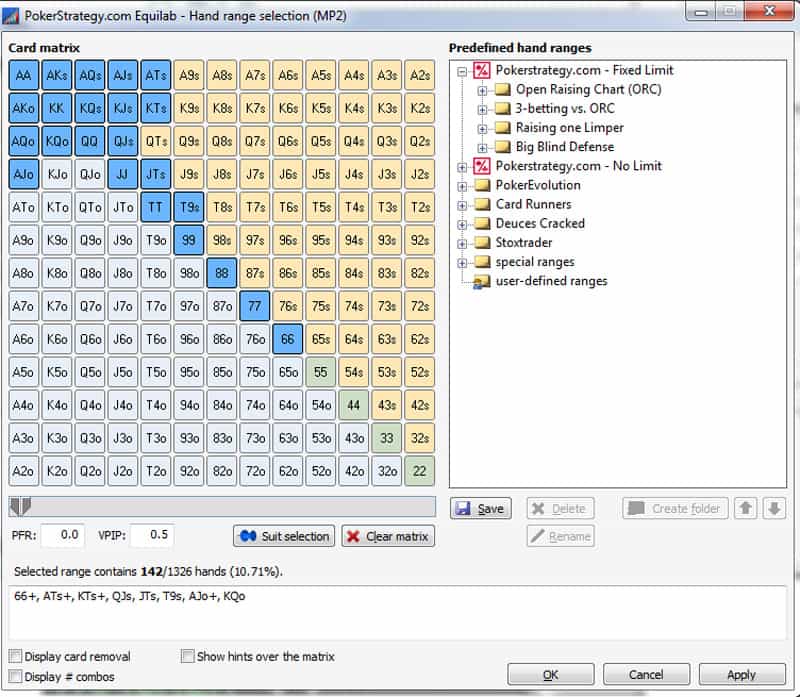Continuation Bet
A continuation bet is simply a bet that is made on the flop if you were the pre-flop raiser, even if you did not improve your hand on the flop. So if you raised pre-flop with A K and the flop came 4 9 Q, you can give yourself a chance of winning the pot by making a bet, despite the fact you have not made a pair or better. Check out this video to better understand when and how much to continuation bet! Jonathan Little is a professional poker player and best-selling poker author with over $7,000,000 in live.
Cbetting Articles:The Continuation Bet : More Cbetting Tips : When To CBet (Examples) : Double Barrelling
SplitSuit's C-Betting Like A Champion concept video is all about how to cbet more effectively. Worth a watch if you're struggling with your cbet frequencies.
In my very first article on continuation betting (cbetting, cbets) I went over the basics of performing cbets in NL Hold’em. In this article I am going to explain how and why certain flop textures are good or bad for cbetting.
This will be more of an example orientated guide, which I’m sure many of you will appreciate more than just the theory.
As I write these examples I’m assuming that we are heads up, have missed the flop (i.e not made a pair, a strong draw or better) and would like to see our opponent fold their hand. We are betting as a bluff rather than for value.
Flop textures for cbetting.
Starting with the best type of flops (flop textures) for cbetting and working my way down, I will explain why each is good, okay or bad for cbet bluffing.
Ace high or King high dry flops.
- Great for cbetting.
- Cbet ~90% of the time.
These are perfect for cbetting because unless your opponent has at the very least 2nd pair they are unlikely to continue with their hand. In fact, a lot of tighter players will fold 2nd pair hands to a cbet OOP, so I pretty much cbet these flops every single time.
The only downside to these flops is that if you hold a hand like KQ on the A83 flop and get called it’s not looking good for the rest of the hand. Nonetheless, it still remains +EV to cbet this close to 90% of the time.
Two high, one low.
- Great for cbetting.
- Cbet ~80% of the time.
These flops are also good for cbetting for the same reason as the A/K high dry flops. These flops hit your perceived range hard and make it difficult for your opponent to call a cbet with less than 2nd pair. Remember that a hand only improves to 1 pair or better on the flop 1/3 of the time, so your opponent will be giving up the pot more often than they peel.
You can try and argue that if your opponent calls your preflop raise, this flop hits their range as well. This is true for the very tight players, but there are so many lower pocket pairs, suited connectors and hands that just flat out miss this flop that it’s still profitable to cbet here a large % of the time.
Just as it is with spiders, your opponents are more afraid of you than you are of them.
One high, two low.
- Good for cbetting.
- Cbet ~60% of the time.
This is pretty much the last of the “good” flops to cbet. Same reasons as before really; this flop could have easily hit your range and if you have 2 overcards like AK or KQ it’s really not the end of the world if you get called.
On these flops you tend to get peeled/floated more often, which is why I like to have some decent equity in the hand with overcards to cbet this one. If I don’t have a decent draw or overcards, I generally avoid cbetting.

Low or wet flops.
- Poor for cbetting.
- Cbet ~25% of the time.
These flops hit your opponent’s preflop calling range hard. Therefore you can expect to see a lot of calls from speculative hands and/or check raises from strong draws if you attempt to cbet bluff.
There’s no need to worry about cbet bluffing low flops or any flops that are really coordinated too frequently. You may be better off taking a free card and keeping the pot size as low as possible by checking in position and just hoping for the best when checking out of position.
If you do decide to cbet these flops, be prepared to fire a second barrel (and maybe even a third).
Broadway flops.
- Bad for cbetting.
- Cbet ~0% of the time.
If you’re thinking about cbet bluffing this flop the chances are that you are holding a lower pocket pair or undercards, where both of which have a very bleak outlook if you get called and therefore have very little equity in the hand.
I don’t believe that you are getting enough folds in this situation to cbet here to make it profitable, so I would definitely advise against it on these sorts of flops. I cbet bluff these flops close to 0% of the time.
When to cbet evaluation.
This isn’t the ultimate guide to cbet bluffing any and every flop imaginable in Texas Hold’em. Sorry. The cbetting percentages I’ve thrown out are really rough estimates as well.
However, these examples should give you an insight to the type of flops I like cbetting and the type of flops I wouldn’t touch with a barge pole after missing the flop. Almost every cbet situation is unique depending on the player(s) you are up against and the cards on the flop. Treat this as a rough foundation.
Go back to the awesome Texas Hold'em Strategy.
Comments

C Bet Poker
A bet from a player on the flop who raised pre-flop is known as a continuation bet or simply a c-bet. That player has continued to seize the initiative, hence the term, continuation bet. The normal use of the continuation bet is by a player in position against a lone opponent who has checked on the flop. The use of a continuation bet is rooted in the wisdom that most of the time one’s hand does not improve on the flop. Therefore the first player to bet may take down the pot right then and there.
Over time the use of this strategy has almost become the 100% default action by many poker players. Right up front we will state that if players employ this poker strategy every time they have taken the lead pre-flop, they are continuation betting too frequently. When this is the case, what can be utilized selectively to one’s benefit can become a major leak. As in all of poker, predictability is analogous to stepping into the cross hairs of all but your most obtuse opponents.
In this lesson we will attempt to explore the why, when and against whom this action should ideally be taken. We will also recommend some counter strategies for when your opponent is the one making a continuation bet.
The Purpose of Continuation Bets
As stated above, the strategy is based upon the fact that a hand is not usually improved upon by the flop so attacking your opponent with further aggression, regardless of your holding, can many times win the pot. It can also be used a reverse bluff when you hold a strong hand and would like to build the pot. The main purpose, however, is to win the pot immediately.

The Number of Opponents
The fewer opponents you are facing the higher your chances of success in winning the pot with a continuation bet. As a general guide, consider the following:
- C-bet almost 100% when heads up
- C-bet 50% when against two players
- C-bet 25% when against three players
Continuation betting against more than one opponent, while much less frequently, gives your game a degree of unpredictability. Although if there are four or more players then you’ll probably want to have hit the flop before sending more chips toward the middle – and a check may be in order.
The Texture of the Board
As the Mad Genius of Poker, Mike Caro, has stated… hold’em is a game of high cards while stud is a game of live cards. Keeping that counsel in mind, if the flop comes Jack, Queen and King there is a high likelihood that one of your opponents may well be holding a match to one of these wheel house cards. They weren’t calling your pre-flop raise with 6-3 offsuit!
The texture of the flop is critical to whether a c-bet is the play with the best expectation. Aside from high cards, be careful of coordinated boards that favor straight and flush draws. Ideally, you’ll want to see a ragged, rainbow flop.
Let’s look at a few examples. Suppose you raise with and get called by the button and the blinds. The flop comes :
Figure 1
This is not a good spot to c-bet. You’re against three opponents and your hand value is only an inside straight. You missed your high cards and flush potential and one of your opponents could have easily connected with such a flop. If checked to, then check and hope you get a free look at the turn. If you bet and then get raised by the button or check-raised by one of the blinds, you would have to fold, so see if you can hit your draw on the turn.
Let’s suppose you’re holding the same hand, yet this time you’re against a single opponent and the flop is dealt :

Figure 2
This is a completely different situation and if your opponent checks it’s a great time for a semi-bluff c-bet to either take the pot right then or if called you have two overs and the second nut flush draw. If you were facing more than one opponent then it would also be a good time to make a continuation bet, unlike the previous example.
You can also make a continuation bet when you flop a very strong hand, such a set. Remember that in poker it’s important to play different hands the same way. If you regularly make continuation bets when you whiff on the flop, you should also bet when you make a strong hand too – so as not to arouse suspicions. Your intention in poker is to manipulate your opponents and one advantage of frequently c-betting is that you will give your good hands some cover and disguise.
Bet Sizing
If you’re playing no-limit hold’em then you will also need to decide the size of your wager when planning a continuation bet. Many factors should contribute to your decision including: opponent playing tendencies, stack sizes and your own table image. You need to balance your bet size for two reasons. Understanding that the strategy is not fool proof… you don’t want to bet too small which will invite a call and to bet too large becomes foolhardy.
But it’s important to be consistent with your betting. Therefore your continuation bets should be the same size as any other post-flop betting and conventional wisdom seems to favor a bet size of at least half the pot. To bet less extends better calling odds to your opponent and to bet more becomes too costly when you run into an opponent that actually has a hand. This is not a hard and fast rule and you’ll find yourself making adjustments through experience, feel and the general nature of the game.
Your Opponents
While it is true that knowledge of how you believe your opponents will react is a universal poker criteria to successful play, when betting into an opponent with nothing, it is good to know how tight or loose he may tend to play.
In addition, just as you are making a play so may be your opponent. Is he savvy enough to be floating you? This is a play in which your opponent may suspect you are continuation betting so he just flat calls expecting you to check on the turn. If you do check after he calls your continuation bet, his intention is to seize upon your apparent weakness and bet to steal the pot.
The factors outlined above are the major criteria one should evaluate to determine the wisdom of making a continuation bet. In a perfect situation you should be in position against a single weak/tight opponent making a bet of about half the pot into a raggedy board. The half pot bet will offer him 3-to-1 odds which aren’t very good drawing odds. If you know your opponent is knowledgeable regarding drawing odds, this becomes a positive to offering him poor odds to a possible draw.
Countering the Continuation Bet
Now let’s take a look at the same situation in the mirror. Instead of aiming the shotgun at a lone opponent, we’ll imagine you are looking down the barrel of the continuation better. At the risk of sounding like a broken record, always be observant of your opponents in order to improve your decision making. Is he aggressive and loose or timid and tight or where in that range does he dwell? You know many players love to see a flop and then feel compelled to fire a continuation bet to end the action. Know your opponent’s tendencies – this knowledge pays dividends.
Reverse Engineering
Reverse engineering is a term used in many fields to describe a process wherein you first dissect a competitor’s product, marketing plan or just about anything in order to determine how it’s made or done with the intention of replicating it or improving upon it. The best way to combat an opponent who is continuation betting is to understand his thought process and, if appropriate, play back at him. Review the following checklist to determine if you’re being manipulated by an opponent’s continuation bet.
- Does he regularly, therefore predictably, continuation bet?
- Does his bet warrant a call based upon your hand?
- Based on his tendencies, is attempting to steal the pot?
- If he is stealing, should you raise, call, or fold?
Identifying the Meaning of Your Opponent’s Bets
There are many different types of bets in addition to continuation bets… value bets, probe bets, and semi-bluffs as examples. There is nothing worse than attempting to thwart what you believe is a continuation bet by calling all the way to the river only to face the ultimate revelation that your opponent was value betting the whole time.
Knowledge is power and it is up to you to observe your opponents betting patterns to understand just how they play the game. It is this knowledge that will help guide you to making quality decisions and when all is said and done – making quality decisions is what separates the winners from the losers.
Conclusion

Continuation betting is a solid poker strategy to employ when the criteria outlined above is in place. However, it should represent only one arrow in your quiver of ploys. As in all of poker, don’t use it every time you have been the pre-flop aggressor as you will become predictable and, therefore, exploitable. Instead, observe your opponents and determine who among them does not understand the wisdom of mixing up one’s game.
Continuation Bets
Related Lessons
By Tom 'TIME' Leonard
Tom has been writing about poker since 1994 and has played across the USA for over 40 years, playing every game in almost every card room in Atlantic City, California and Las Vegas.